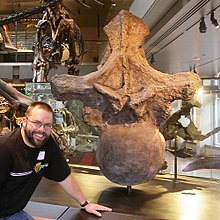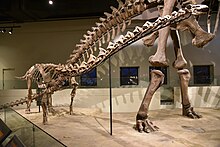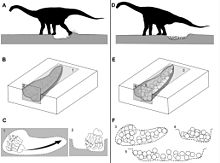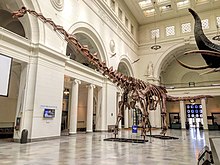Titanosauria
Titanosaurs (or titanosaurians; members of the group Titanosauria) were a diverse group of sauropod dinosaurs, including genera from all seven continents. The titanosaurs were the last surviving group of long-necked sauropods, with taxa still thriving at the time of the extinction event at the end of the Cretaceous. This group includes some of the largest land animals known to have ever existed, such as Patagotitan—estimated at 37 m (121 ft) long[13] with a weight of 69 tonnes (76 tons)[14]—and the comparably-sized Argentinosaurus and Puertasaurus from the same region.
The group's name alludes to the
Fossil record

Due to the near-global distribution of titanosaurs during the Cretaceous, titanosaur fossils have been found on every continent, including Antarctica.[15] However, titanosaurs have the least complete fossil record of any major sauropodomorph group.[16] No complete titanosaur skeletons are known, and many species are only known from a few bones. Titanosaur skulls are especially rare. Though fragmentary cranial remains are known for several titanosaur genera, nearly complete skulls have been described for only four: Nemegtosaurus, Rapetosaurus, Sarmientosaurus, and Tapuiasaurus.[17] As is the case in most other sauropod groups, there are few titanosaur specimens with complete necks preserving all of the cervical vertebrae in sequence. Only three complete titanosaur necks are known: the holotype of Futalognkosaurus and two undescribed specimens from Argentina. A fourth specimen, of an unidentified titanosaur from Brazil, preserves a nearly complete neck, with only the atlas, the tiny vertebra forming the joint between the skull and neck, missing.[18] Only five titanosaur specimens preserve complete, articulated hind feet.[19] This incompleteness is especially significant for giant titanosaurs, which are generally known from disarticulated and fragmentary remains.[19]
Titanosaurs are one of the few groups of dinosaurs for which fossil eggs are known.
Description
Titanosauria have the largest range of body size of any sauropod clade, and includes both the largest known sauropods and some of the smallest.[23] One of the largest titanosaurs, Patagotitan, had a body mass estimated to be 69 tonnes (76 tons), whereas one of the smallest, Magyarosaurus, had a body mass of approximately 900 kilograms (2,000 lb).[14][24] Even relatively closely related titanosaurs could have very different body sizes, as the small rinconsaurs were closely related to the gigantic lognkosaurs.[14] Fossils from perhaps the largest dinosaur ever found were discovered in 2021 in the Neuquén Province of northwest Patagonia, Argentina. It is believed that they are from a titanosaur.[25][26] Some of smallest titanosaurs, such as Magyarosaurus, inhabited Europe, which was largely made up of islands during the Cretaceous, and were likely island dwarfs. Another taxon of tiny titanosaurs, Ibirania, lived a non-insular context in Upper Creaceous Brazil, and is an example of nanism resultant from other ecological pressures.[27]
Head and neck

The heads of titanosaurs are poorly known. However, several different cranial morphologies are apparent. In some species, such as Sarmientosaurus, the head resembled that of brachiosaurids.[17] In others, such as Rapetosaurus and Nemegtosaurus, the head resembled that of diplodocids. In some titanosaurs, the skull was especially diplodocid-like due to square-shaped jaws;[28] the titanosaur Antarctosaurus is especially similar to the rebbachisaurid Nigersaurus.[29] Titanosaurs had small heads, even when compared with other sauropods. The head was also wide, similar to the heads of Camarasaurus and Brachiosaurus, though somewhat more elongated. Titanosaurian nostrils were large ("macronarian") and all had crests formed by the nasal bones. Their teeth were either somewhat spatulate (spoon-like) or like pegs or pencils, but were always very small.
Titanosaur necks were of average length for sauropods, and their
Torso and limbs

The
Sauropod hands already are highly derived from other dinosaurs, being reduced into columnar
Titanosaurs have a poor fossil record of their
Integument

From skin impressions found with fossils, it has been determined that the skin of many titanosaurs was armored with a small mosaic of small, bead-like scales surrounding larger scales.[21] While most titanosaurs were very large animals, many were fairly average in size compared to other giant dinosaurs. Some island-dwelling dwarf titanosaurs, such as Magyarosaurus, were probably the result of allopatric speciation and insular dwarfism.
Some titanosaurs had
Classification
| ||||||||||||||||||||||||||||||||||||||||||
| Phylogenetic position of Titanosauria within Eusauropoda[42] |
Titanosaurs are classified as sauropod dinosaurs. This highly diverse group forms the dominant clade of Cretaceous sauropods.[43] Within Sauropoda, titanosaurs were once classified as close relatives of Diplodocidae due to their shared characteristic of narrow teeth, but this is now known to be the result of convergent evolution.[44] Titanosaurs are now known to be most closely related to euhelopodids and brachiosaurids; together they form a clade named Titanosauriformes.[45]
For much of the 20th century, most known species of titanosaurs were classified in the family Titanosauridae, which is no longer in widespread use.[7] Titanosauria was first proposed in 1993 as a taxon to encompass titanosaurids and their close relatives.[46] It has been phylogenetically defined as the clade composed of the most recent common ancestor of Saltasaurus and Andesaurus and all of its descendants.[44][7][47][48][36][45] The relationships of species within Titanosauria remain largely unresolved, and it is considered one of the most poorly-understood areas of dinosaur classification. One of the few areas of agreement is that the majority of titanosaurs except Andesaurus and some other basal species form a clade called Lithostrotia, which some researchers consider equivalent to the deprecated Titanosauridae.[7][49][48] Lithostrotians include titanosaurs such as Alamosaurus, Isisaurus, Malawisaurus, Rapetosaurus, and Saltasaurus.[49]
Early history
For his
A brief review of putative titanosaurids from Europe was authored by Jean Le Loeuff in 1993, and covered the supposed genera known so far. The Barremian (middle Early Cretaceous) species Titanosaurus valdensis, named decades previous by Huene, was kept as the oldest of the titanosaurid and given the new genus name Iuticosaurus. The French taxon Aepisaurus was removed from the family and placed in undetermined Sauropoda. Macrurosaurus was considered a chimaera of titanosaurid and non-titanosaurid material because of the presence of both procoelous and amphicoelous caudals. Huene's species Titanosaurus lydekkeri was left as a nomen dubium, but left within Titanosauridae. Maastrichtian fossils from France and Spain were removed from Hypselosaurus and Titanosaurus, with Hypselosaurus being declared dubious like T. lydekkeri. The variety of Romanian fossils named as Magyarosaurus by Huene were also moved into the same species again, M. dacus as originally named by Nopcsa.[57]
Titanosauria named

José Bonaparte and Rodolfo Coria in
Overlooking the naming of Titanosauria,
In

| Titanosauria |
| |||||||||||||||||||||||||||||||||
Contributing additional work to the systematics of titanosaurs, Spanish paleontologist
Argentinian paleontologist Jaime Powell published his 1986 thesis in 2003, with revisions to bring his old work up to date, including the addition of more phylogenetics and the recognition of Titanosauria as a clade name. Using the datamatrix of Sanz et al. (1999) and modifying it to include additional taxa and some character changes, Powell found that titanosaurs formed mostly a single gradual radiation beginning with Epachthosaurus as the most basal titanosaur, and Ampelosaurus and Isisaurus as the most derived. Titanosauroidea (following Upchurch 1995), was distinguished by pre- and post-spinal laminae in anterior caudals, a laterally flared ilium, a lateral expansion of the upper femur, and strongly opisthocoelous posterior dorsals. Less inclusive, Titanosauria was diagnosed by horizontally facing dorsal diapophyses, prominent procoelous anterior caudals, and a ridge on the sternal plates. Within Titanosauria, Eutitanosauria was characterized by the absence of a hyposphene-hypantrum, no femoral fourth trochanter, and osteoderms. A small clade of Alamosaurus, Lirainosaurus and the "Peirópolis titanosaur" (Trigonosaurus) was resolved, and diagnosed by only a rotation of the tibia so the proximal end is perpendicular to the distal end. More derived clades, while resolved, were only weakly supported, or characterized by reversions of diagnostic traits of larger groups (below and left).[61]
|
Powell (2003)
|
Curry-Rogers & Forster (2001)
|

American paleontologist Jeff Wilson presented another revision of overall sauropod phylogeny in 2002, resolving strong support for most groups, and a similar result to Upchurch (1998) although with Euhelopus closest to titanosaurs instead of outside Neosauropoda. More internal clades were resolved for Titanosauria, with Nemegtosaurus and Rapetosaurus united within Nemegtosauridae, and Saltasauridae including two subfamilies, Opisthocoelicaudiinae and Saltasaurinae. Saltasauridae was defined as a node-stem triplet, where everything descended from the common ancestor of Opisthocoelicaudia and Saltasaurus was within Saltasauridae, and the subfamilies Saltasaurinae and Opisthocoelicaudiinae were for every taxon on one branch of the saltasaurid tree or the other.[29]
Wilson and Paul Upchurch followed this study up in 2003 with a significant revision of the type genus Titanosaurus, and revisited all the material that had been assigned to the genus while reviewing titanosaur inter-relationships. Because they found Titanosaurus to be a dubious name, they proposed that Linnaean-named groups Titanosauridae and Titanosauroidea should be considered invalid as well. Wilson & Upchurch (2003) supported the definition of Salgado et al. (1997) for Titanosauria, since it was oldest and most similar to the original content of the group when named by Bonaparte & Coria (1993). Lithostrotia (Upchurch et al. 2004) was defined to be Malawisaurus and all more derived titanosaurs, and the clade Eutitanosauria (Sanz et al. 1999) was considered a possible synonym of Saltasauridae. Wilson & Upchurch (2003) presented a reduced cladogram of Titanosauria, including only the most commonly-analyzed taxa from previous studies, resulting in a tree similar to that of Wilson (2002) but with Rapetosaurus and Nemegtosaurus excluded and Epachthosaurus included. Alamosaurus and Opisthocoelicaudia were united within Opisthocoelicaudiinae, Neuquensaurus and Saltasaurus formed Saltasaurinae, and Isisaurus placed as the next most derived titanosaurid.[7]

At the same time as Wilson & Upchurch redescribing the species of Titanosaurus, Saldago (2003) looked over the potential invalidity of the family Titanosauridae and redefined the internal clades of Titanosauria.

Following the clade definitions proposed in previous Salgado studies, Bernardo González-Riga published two papers in 2003 describing new taxa in Titanosauria: Mendozasaurus, and Rinconsaurus (with Jorge O. Calvo). In both studies, the new taxa formed clades within Titanosauridae, although neither were named, and new diagnostic features were proposed for the family.[64][65] For Mendozasaurus, the new genus grouped with Malawisaurus as basal within Titanosauridae, but because of the features of caudal vertebrae in these basal taxa, González-Riga recommended revising the diagnosis of the family, instead of changing the content.[64] The situation of caudals in Rinconsaurus also suggested procoelous caudals were no longer diagnostic, because in the tail of Rinconsaurus the vertebrae regularly changed their articular surfaces, being from procoelous caudals interspersed with amphicoelous, opisthocoelous and biconvex vertebrae.[65] Rinconsaurus was then included in Aeolosaurini, a clade named the following year by Aldirene Franco-Rosas et al. containing everything closer to Aeolosaurus and Gondwanatitan than Saltasaurus or Opisthocoelicaudia. Only the three genera and various intermediate specimens were included in Aeolosaurini in their 2004 paper, with the tribe being considered to be within Saltasaurinae.[66]
The second edition of The Dinosauria, published in 2004, included newly described titanosaurs and other taxa reidentified as titanosaurs. Written by Upchurch, Paul Barrett and Peter Dodson, a review of Sauropoda included a more expansive Titanosauria for sauropods more derived than brachiosaurids. Titanosauria, defined as everything closer to Saltasaurus than Brachiosaurus, included a very large variety of taxa, and the new clade Lithostrotia was named for a large number of more derived taxa, although Nemegtosauridae was placed in Diplodocoidea following earlier publications of Upchurch.[49] Lithostrotia adopted the distinguishing feature of strongly procoelous caudals, previously used for Titanosauria.[7][49]
New phylogenetic frameworks
In 2005, Curry-Rogers proposed a new phylogenetic analysis that focused on the inter-relationships of Titanosauria and included the most expansive character and taxon list of any study before it. 364 characters were selected from all previous phylogenetic analyses and scored across 29 probable titanosaurs, ranging from the Late Jurassic African Janenschia to the large variety of Late Cretaceous global genera. Proposing her analysis as the basis for a new phylogenetic framework of Titanosauria, Curry-Rogers recommended only using named for clades that were very strongly supported. For the strict consensus, every taxon more derived than Brachiosaurus was in an unresolved polytomy except for a clade of Rapetosaurus and Nemegtosaurus, and one of Saltasaurinae. Within the recommended results, she only named Titanosauria, Lithostrotia, Saltasauridae, Saltasaurinae and Opisthocoelicaudiinae, because of the weakness of support (below and left).[47]
|
Curry-Rogers (2005)
|
Carballido et al. (2017)
|
Another form of composite matrix was created by Calvo, González-Riga and Juan Porfiri in 2007, based upon multiple previous studies between 1997 and 2003. The final analysis included 15 titanosaurs and 65 characters, and the typical titanosaur subclades were resolved, Titanosauridae being used over Lithostrotia following Salgado (2003), and the new clade Rinconsauria for the clade of Rinconsaurus and Muyelensaurus. The new clade (defined as Rinconsaurus and Muyelensaurus) was placed as the sister taxon of Aeolosaurini, which together grouped with Rapetosaurus as sister to Saltasauridae.[48] In the same year, Calvo et al. published another paper, describing the basal titanosaur Futalognkosaurus. The only difference in the resulting phylogeny, based on the matrix of the Calvo, González-Riga & Porfiri (2007), was the addition of Futalognkosaurus as the sister taxon to Mendozasaurus in a clade Calvo et al. named Lognkosauria, defined by the two genera classified within it.[67] A very similar result was also recovered by González-Riga et al. in 2009 in a phylogenetic analysis based partially on that of Calvo et al. (2007), although Epachthosaurus was nested with Rapetosaurus outside the clades of aeolosaurines.[68] Further updates and modifications were then made by Palbo Gallina & Apesteguía in 2011, with the additions of Ligabuesaurus, Antarctosaurus, Nemegtosaurus and Bonitasaura and character updates to match, bringing the total to 77 characters and 22 taxa. Significantly contrasting the earlier results, internal relationships of Titanosauria were rearranged. Malawisaurus nested with Andesaurus in a clade of the basalmost titanosaurs outside Titanosauroidea, where Lirainosaurus, instead of being the basal member of the saltasaur-branch was instead basalmost titanosauroid. Lognkosauria moved to be within rinconsaurs, while Nemegtosauridae was resolved as the sister of Aeolosaurus and Gondwanatitan, and the rinconsaur-lognkosaur branch. Antarctosaurus was unstable, but placed in a polytomy with the lognkosaurs and rinconsaurs before being excluded. Saltasaurinae and its relationship with Opisthocoelicaudia remained the same.[69]
Nemegtosauridae was additionally revised by Hussam Zaher et al. (2011) with the description of Tapuiasaurus, which nested closer to Rapetosaurus than Nemegtosaurus, with all three forming a clade of derived lithostrotians. Using the matrix of Wilson (2002), following the additions of a few cranial characters and Diamantinasaurus, Tangvayosaurus and Phuwiangosaurus, remained the same as originally found by Wilson but with Diamantinasaurus sister to Saltasauridae and the other two genera as basal titanosaurs outside Lithostrotia, since Titanosauria, while undefined, was labelled to include all taxa closer to Saltasaurus than Euhelopus.[70] Following a revision of the skull of Tapuiasaurus, Wilson et al. (2016) rescored the analysis of Zaher et al. and recovered similar results for everything but Nemegtosauridae, where the family dissolved into a more basal Tapuiasaurus outside Lithostrota and Nemegtosaurus outside Saltasauridae. While non-titanosaur phylogeny remained identical in every single result, the topology within Titanosauria was very labile and prone to change with minor adjustments.[71]
Also following the 2002 analysis of Wilson, José Carballido and colleagues published a redescription of Chubutisaurus in 2011, and utilized an updated Wilson matrix, expanded to 289 characters across 41 taxa, including 15 titanosaurs. The primary focus of the analysis was on the basal titanosauriform taxa, but Titanosauria was defined, as the most recent common ancestor of Andesaurus delgadoi and Saltasaurus loricatus, and all its descendants, although the only autapomorphy of the group recovered was the absence of a prominent ventral process on the scapula.[72] This same matrix and basis of characters was further utilized and expanded for analyses on Tehuelchesaurus, Comahuesaurus and related rebbachisaurs, Europasaurus, and Padillasaurus, before being expanded upon once again in 2017 by Carballido et al. during the description of Patagotitan to 405 characters and 87 taxa, including 28 titanosaurs (above and right).[73][74][75][76][77] The definition of Titanosauria was preserved following Salgado et al. (1997) as Andesaurus plus Saltasaurus. Eutitanosauria (closer to Saltasaurus than Epachthosaurus) was resolved as a very inclusive clade composed of two distinct branches, one leading to the larger-bodied lognkosaurs and the other to the smaller-bodied saltasaurs. On the lognkosaur branch of Eutitanosauria, there is a branch of lognkosaurs and one of Rinconsauria. Following Calvo, González-Riga and Porfiri (2007), Rinconsauria was defined as Muyelensaurus plus Rinconsaurus, and Lognkosauria was defined as Mendozasaurus plus Futalognkosaurus. Rinconsauria included taxa typically found within Aeolosaurini as well, so Aeolosaurini was redefined as Aeolosaurus rionegrinus plus Gondwanatitan to preserve the original restricted content, otherwise the entire rinconsaur-lognkosaur branch would be classified within Aeolosaurini. Lithostrotia, Saltasauridae and Saltasaurinae had their definitions preserved from earlier studies, and included their typical content.[77]
Philip Mannion and colleagues redescribed Lusotitan in 2013, creating a new analysis of 279 characters drawn from significant previous analyses by Upchurch and Wilson supplemented by other studies. 63 sauropods were included, focusing on non-titanosaurian sauropods, although 14 probable titanosaurs were included. Unique to Mannion et al., continuous characters were distinguished in a run of the matrix, which resolved almost all of Somphospondyli within Titanosauria because of Andesaurus placing very basal in a large group of Andesauroidea. Titanosauroidea was tentatively retained as the opposite clade of titanosaurs, which included all other traditional titanosaurs, although it was noted because of the invalidity of Titanosaurus, Titanosauroidea should be considered an invalid name as well.[45] While the original analysis didn't focus on titanosaurs, it was utilised during the descriptions of Savannasaurus and Diamantinasaurus, Yongjinglong, an osteology of Mendozasaurus, and redescribing Tendaguria.[34][78][79][80][42] From these updates, an analysis of 548 characters and 124 taxa was published by Mannion et al. in 2019 for a redescription of Jiangshanosaurus and Dongyangosaurus, and additional revisions of Ruyangosaurus were made. No differentiation between continuous and discrete characters was made like performed by Mannion et al. (2013), but a large clade of Andesauroidea was still resolved with implied weights. Both redescribed Asian taxa, as well as Yongjinglong, previously considered derived titanosaurs related to Saltasauridae, were removed to outside the clade.[81]
| Titanosauria | |
In the description of Mansourasaurus, Sallam et al. (2017) published a phylogenetic analysis of Titanosauria including the most taxa of any analysis of the clade.[82] In an updated version of the analysis, with the taxon Mnyamawamtuka added, Gorscak & O'Connor (2019) got similar results, with slightly different relationships within small clades.[12]

| Titanosauria | |
Paleobiology
Diet
Nesting

A large titanosaurid
Range

The titanosaurs were the last great group of sauropods, which existed from about 136
Titanosaurs were widespread. In December 2011, Argentine scientists announced titanosaur fossils had been found on Antarctica
Paleopathology
Ibirania, a nanoid titanosaur fossil from Brazil suggests that individuals of various genera were susceptible to diseases such as osteomyelitis and parasite infestations. The specimen hails from the late cretaceous São José do Rio Preto Formation, Bauru Basin, and was described in the journal Cretaceous Research by Aureliano et al. (2021).[91] Examination of the titanosaur's bones revealed what appear to be parasitic blood worms similar to the prehistoric Paleoleishmania but are 10-100 times larger, that seemed to have caused the osteomyelitis. The fossil is the first known instance of an aggressive case of osteomyelitis being caused by blood worms in an extinct animal.[92][93][94]
References
- S2CID 214244529.
- S2CID 677002.
- .
- PMID 27115989.
- .
- PMID 34385481.
- ^ S2CID 53997295.)
{{cite journal}}: CS1 maint: multiple names: authors list (link - PMID 31598266.
- S2CID 248368302.
- S2CID 248368302.
- .
- ^ PMID 30759122.
- ^ "Giant dinosaur slims down... a bit". BBC News. 10 August 2017. Retrieved 8 April 2020.
- ^ PMID 28794222.
- ^ S2CID 18921496.
- ISSN 0031-0239.
- ^ PMID 27115989.)
{{cite journal}}: CS1 maint: multiple names: authors list (link - PMID 35127288.
- ^ ISBN 978-3-030-95958-6.
- S2CID 219730449.
- ^ S2CID 131612932.
- S2CID 221343275.
- ^ Wilson, J. A. (2006). "An overview of titanosaur evolution and phylogeny". Actas de las III Jornadas sobre Dinosaurios y su Entorno. Salas de los Infantes, Burgos, Spain. pp. 169–190.
- PMID 20435913.
- ^ Baker, Harry (2021). "Massive new dinosaur might be the largest creature to ever roam Earth". LiveScience.com. Retrieved 22 January 2021.
- S2CID 233582290.
- S2CID 251875979.
- S2CID 33590452.
- ^ hdl:2027.42/73066.
- ^ Apesteguía, S. (2005). "Evolution of the titanosaur metacarpus". Pp. 321–345 in Tidwell, V. and Carpenter, K. (eds.) Thunder-Lizards: The Sauropodomorph Dinosaurs. Indianapolis: Indiana University Press.
- .
- ISBN 0-253-34542-1.
- ISBN 0-253-34542-1.
- ^ hdl:10044/1/27497.
- PMID 26777391.
- ^ .
- PMID 25118985.
- PMID 22127060.
- PMID 28169348.
- S2CID 86797277.
- S2CID 239121820.
- ^ hdl:10044/1/64080.
- PMID 31340217.
- ^ a b c Salgado, L.; Coria, R.A.; Calvo, J.O. (1997). "Evolution of titanosaurid sauropods. I: Phylogenetic analysis based on the postcranial evidence". Ameghiniana. 34 (1): 3–32.
- ^ .
- ^ a b Bonaparte, J.F.; Coria, R.A. (1993). "Un nuevo y gigantesco sauropodo titanosaurio de la Formacion Rio Limay (Albiano-Cenomaniano) de la Provincia del Neuquen, Argentina". Ameghiniana. 30 (3): 271–282.
- ^ ISBN 0-520-24623-3.
- ^ a b c Calvo, J.O.; González-Riga, B.J.; Porfiri, J.D. (2007). "A new titanosaur sauropod from the Late Cretaceous of Neuquén, Patagonia, Argentina". Arquivos do Museu Nacional, Rio de Janeiro. 65 (4): 485–504.
- ^ ISBN 0-520-24209-2.
- ^ Lydekker, R. (1877). "Notice of new and other Vertebrata from Indian Tertiary and Secondary rocks". Records of the Geological Survey of India. 10 (1): 30–43.
- ^ Lydekker, R. (1888). "Part I. Containing the orders Ornithosauria, Crocodilia, Dinosauria, Squamata, Rhynchocephalia and Proterosauria". Catalogue of the fossil Reptilia and Amphibia in the British Museum (Natural History). British Museum of Natural History. pp. 134–136.
- ^ Lydekker, R. (1893). "Part I. The dinosaurs of Patagonia". Contributions to a knowledge of the fossil vertebrates of Argentina. Vol. 2. Anales del Museo de La Plata. pp. 1–14.
- ^ Nopcsa, F. (1928). "The genera of reptiles". Palaeobiologica. 1: 184.
- ^ Huene, F. von (1929). "Los Saurisquios y Ornitisquios del Cretáceo Argentino". Anales del Museo de la Plata. 3 (2): 1–196.
- ^ Powell, J.E. (1986). "Revision de los Titanosauridos de America del Sur". PhD Thesis. Universidad Nacional de Tucuman Facultad de Ciencas Naturales: 1–340.
- ^ ISBN 0-520-06726-6.
- ^ Le Loeuff, J. (1993). "European titanosaurids". Revue de Paléobiologie. Spécial (7): 105–117.
- .
- .
- ^ Sanz, J.L.; Powell, J.E.; Le Loeuff, J.; Martinez, R.; Pereda-Suberbiola, X. (1999). "Sauropod remains from the Upper Cretaceous of Laño (Northcentral Spain). Titanosaur phylogenetic relationships". Estudios del Museo de Ciencias Naturales de Alava. 14 (1): 235–255.
- ^ Powell, J.E. (2003). "Revision of South American Titanosaurid dinosaurs: palaeobiological, palaeobiogeographical and phylogenetic aspects". Records of the Queen Victoria Museum. 111: 1–173.
- S2CID 4347583.
- ^ a b Salgado, L. (2003). "Should we abandon the name Titanosauridae? Some comments on the taxonomy of Titanosaurian Sauropods (Dinosauria)". Revista Española de Paleontología. 18 (1): 15–21.
- ^ a b González-Riga, B.J. (2003). "A new titanosaur (Dinosauria, Sauropoda) from the Upper Cretaceous of Mendoza Province, Argentina". Ameghiniana. 40 (2): 155–172.
- ^ .
- .
- PMID 17768539.
- .
- hdl:11336/192915.
- PMID 21326881.
- hdl:2027.42/134419.
- S2CID 86055386.
- hdl:11336/71888.
- S2CID 130423764.
- S2CID 85087382.
- S2CID 129498917.
- ^ PMID 28794222.
- PMID 27763598.
- PMID 24489684.
- hdl:10044/1/53967.
- PMID 31598266.
- S2CID 3375335.
- S2CID 1816461.
- PMID 20463953.
- ^ .
- ^ Roberts, Greg (3 May 2007). "Bones reveal Queensland's prehistoric titans". The Australian. Retrieved 4 May 2007.
- ISBN 978-0-253-34542-4.
- ^ "Bone discovery confirms big dinosaur roamed NZ". The New Zealand Herald. 24 June 2008. Retrieved 18 January 2009.
- ^ "Giant footprint could shed light on titanosaurus behaviour". BBC News Online. 5 October 2016. Retrieved 5 October 2016.
- ISSN 0195-6671.
- S2CID 225134198.
- S2CID 225134198.
- ^ Baraniuk, Chris (January 2021). "Gruesome 'Blood Worms' Invaded a Dinosaur's Leg Bone, Fossil Suggests". Scientific American.
- ^ "Cretaceous Titanosaur Suffered from Blood Parasites and Severe Bone Inflammation | Paleontology | Sci-News.com". Breaking Science News | Sci-News.com.

